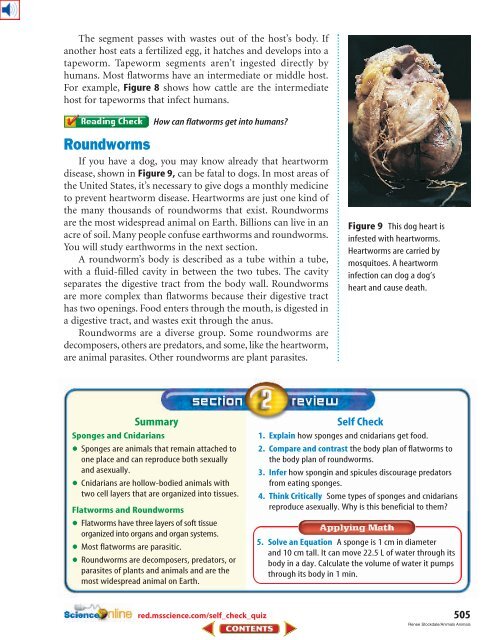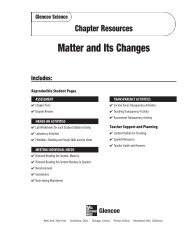Chapter 17: Invertebrate Animals
Chapter 17: Invertebrate Animals
Chapter 17: Invertebrate Animals
Create successful ePaper yourself
Turn your PDF publications into a flip-book with our unique Google optimized e-Paper software.
The segment passes with wastes out of the host’s body. If<br />
another host eats a fertilized egg, it hatches and develops into a<br />
tapeworm. Tapeworm segments aren’t ingested directly by<br />
humans. Most flatworms have an intermediate or middle host.<br />
For example, Figure 8 shows how cattle are the intermediate<br />
host for tapeworms that infect humans.<br />
How can flatworms get into humans<br />
Roundworms<br />
If you have a dog, you may know already that heartworm<br />
disease, shown in Figure 9, can be fatal to dogs. In most areas of<br />
the United States, it’s necessary to give dogs a monthly medicine<br />
to prevent heartworm disease. Heartworms are just one kind of<br />
the many thousands of roundworms that exist. Roundworms<br />
are the most widespread animal on Earth. Billions can live in an<br />
acre of soil. Many people confuse earthworms and roundworms.<br />
You will study earthworms in the next section.<br />
A roundworm’s body is described as a tube within a tube,<br />
with a fluid-filled cavity in between the two tubes. The cavity<br />
separates the digestive tract from the body wall. Roundworms<br />
are more complex than flatworms because their digestive tract<br />
has two openings. Food enters through the mouth, is digested in<br />
a digestive tract, and wastes exit through the anus.<br />
Roundworms are a diverse group. Some roundworms are<br />
decomposers, others are predators, and some, like the heartworm,<br />
are animal parasites. Other roundworms are plant parasites.<br />
Figure 9 This dog heart is<br />
infested with heartworms.<br />
Heartworms are carried by<br />
mosquitoes. A heartworm<br />
infection can clog a dog’s<br />
heart and cause death.<br />
Summary<br />
Sponges<br />
•<br />
and Cnidarians<br />
Sponges are animals that remain attached to<br />
one place and can reproduce both sexually<br />
•<br />
and asexually.<br />
Cnidarians are hollow-bodied animals with<br />
two cell layers that are organized into tissues.<br />
•<br />
Flatworms and Roundworms<br />
Flatworms have three layers of soft tissue<br />
organized into organs and organ systems.<br />
•<br />
Most flatworms are parasitic.<br />
Roundworms are decomposers, predators, or<br />
parasites of plants and animals and are the<br />
most widespread animal on Earth.<br />
Self Check<br />
1. Explain how sponges and cnidarians get food.<br />
2. Compare and contrast the body plan of flatworms to<br />
the body plan of roundworms.<br />
3. Infer how spongin and spicules discourage predators<br />
from eating sponges.<br />
4. Think Critically Some types of sponges and cnidarians<br />
reproduce asexually. Why is this beneficial to them<br />
5. Solve an Equation A sponge is 1 cm in diameter<br />
and 10 cm tall. It can move 22.5 L of water through its<br />
body in a day. Calculate the volume of water it pumps<br />
through its body in 1 min.<br />
red.msscience.com/self_check_quiz<br />
505<br />
Renee Stockdale/<strong>Animals</strong> <strong>Animals</strong>














